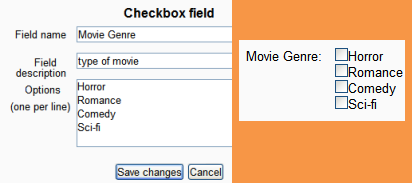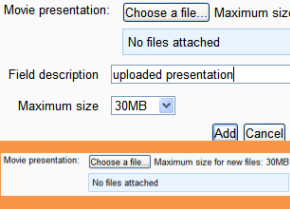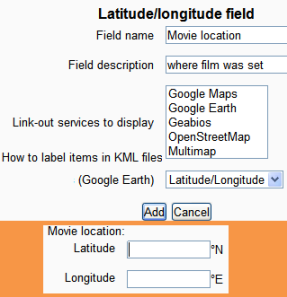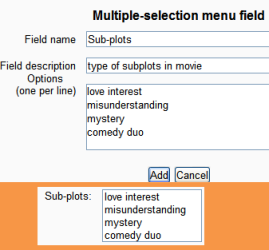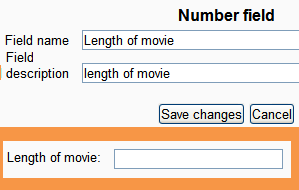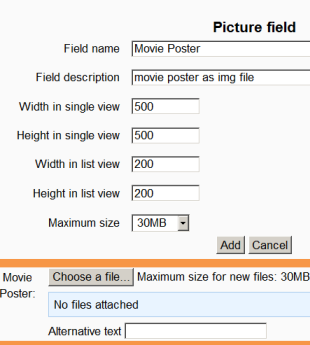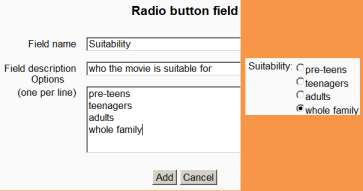Construyendo BasedeDatos
Primeramente deberá crear una base de datos, como se describe en Configuraciones de actividad BasedeDatos. Después, ...
- A continuación Usted define el tipo de campos que definen la información que Usted desea colectar, Por ejemplo, una base de datos de pinturas famosas podría tener un campo para la imagen llamado pintura, para subir un archivo de imagen que muestre la pintura, y dos campos de texto llamados artista and titulo para el nombre del artista y el de la pintura. Alternativamente, Usted puede usar una preconfiguración de base de datos (vea debajo).
- Entonces será opcional el editar las Plantillas de BasedeDatos para alterar la forma en la cual la base de datos muestra las entradas.
Campos de BasedeDatos
Un campo es una unidad nombrada de información. Cada entrada en una Módulo de actividad BasedeDatos puede tener varios campos de varios tipos; por ejemplo, un campo de texto llamado 'color favorito' que le permite a Usted escribir su tono favorito, o un menú llamado 'estado' que le permite elegir uno de entre los 50 que forman los Estados Unidos de América. Al combinar varios campos con nombres y tipos apropiados, Usted debería de poder capturar toda la información relevante acerca de los ítems en su base de datos.
Nota: Pendiente de Traducir. ¡Anímese a traducir esta página!. ( y otras páginas pendientes)
Note that if you later edit the fields in the databases you must use the Reset template button, or manually edit the template, to ensure the new fields are added to the display.
Nombre y descripción del campo
The name is what is shown when an entry is added. It must be unique and short. The description is for your benefit to help identify that field.
¡Nueva característica
en Moodle 2.9!
Campo requerido
If you need to ensure one or several particular fields are always completed, then tick the box 'Required field' when setting up the fields for your database. The field(s) will display a red asterisk when students contribute to the database, and they will not be able to save their work until they have entered the relevant information. A new column will show the teacher which fields are required and not:
Tipos de Campos
The following screenshots show "before" and "afters" of setting up fields. The selection in orange shows the field as it is displayed for the user when they add an entry.
- Checkbox
- This allows you to offer checkboxes for the user to select. Add the options one under the other. The word will appear next to a checkbox when the user clicks to add an entry. They can check more than one box.
- Date
- This allows a user to enter a date by picking a day, month and year from a drop down list.
- File
- Users can upload a file from their computer. If it is an image file then the picture field may be a better choice.
- Latitude/longitude
- Users can enter a geographic location using latitude and longitude. For example, Moodle HQ is at latitude -31.9545, longitude 115.877. When viewing the record, links are automatically generated linking to geographic data services such as Google Earth, OpenStreetMap, GeaBios,Mapstars and more. (The teacher can choose which of those links appear, if any.)
- Data input requirements: Data for this field must be input relative to North and East coordinates. To convert coordinates from West (e.g. 120W) to East, simply input them into the field with a '-' in front (e.g., -120). Also, data must also be input in decimal format, not degree format. Simple converters are a web search away.
- Menu
- The text entered in the options area will be presented as a drop-down list for the user to choose from. Each line become a different option.
- Menu (Multi-select)
- The text entered in the options area will be presented as a list for the user to choose from and each line become a different option. By holding down control or shift as they click, users will be able to select multiple options. This is a fairly advanced computer skill so it may be wise to use multiple checkboxes instead.
- Number
- This allows users to enter any number. For example:
- 42
- -1000
- 0
- 0.123
- 3.0e8
- (For those who care about the technical details, the field stores floating point numbers.)
- Picture
- This allows a user to upload and display an image file. "Single view" is when the image is viewed on its own; "list view" is when it is viewed in with other images. Single view can be larger than list view.
- Radio buttons
- The user gets radio buttons and can choose only one. They can only submit the entry when they have clicked on one button. (Note:If you only have two options and they are opposites (true/false, yes/no) then you could simply use a single checkbox instead. However checkboxes default to their unchecked status and so people could submit without actively selecting one of the options. This may not always be appropriate.)
- Text input
- Users can enter text up to 60 characters in length. For longer text, or for text that requires formatting such as headers and bullet points, you can use a text area field.
- Text area
- This allows users to enter a long piece of text using the text editor.
- URL
- The user can add a link to a website here. If you select autolink then the URL becomes clickable.. If you also enter a forced name for the link then that text will be used for the hyperlink. For example in a database of authors you may wish people to enter the author's website. If you enter the text 'homepage' as a forced name then clicking on text "homepage" will take you to the entered URL.
You can choose to have the URL open in a new window if so desired.
Preconfiguraciones (Presets)
To avoid the necessity of always having to create a new database from scratch, the database activity module has a presets feature. An image gallery preset is included in the database module or you can browse and download one from the Database presets database on Moodle.net. You can create your own presets as well and share them with others.
Importando una preconfiguración
To use a preset:
- On the database page, click the Presets tab.
- The usual way to import a preset is clicking the "Choose file" button and browsing to the ZIP file containing the preset (eg. "preset.zip") stored on the server. If there does not yet exist a preset ZIP file on the server, upload it from your local machine. Choose the desired preset file by clicking on its action "Choose". Finally, press the "Import" button.
- Alternatively, you can choose a previously loaded preset.
- After the import, you can start to add or import entries. All the hard work of setting up the fields and templates has been done for you. If you desire, you can still customize the fields and templates.
You will see a "Overwrite current settings" checkbox after the "Import" button has been pressed. If checked, the database activity overwrites some of its current general settings by those stored in the preset:
- the "Introduction" HTML text
- "Required entries"
- "Entries required before viewing"
- "Maximum entries"
- "Comments"
- "Require approval?"
- rssarticles
Exportando una preconfiguración
If you wish to share your database presets with others, you have two options:
- Export as a ZIP file, which can then be imported to another course or Moodle site.
- Save as a preset, which publishes the database for other teachers on your site to use. It will then appear in the preset list. (You can delete it from the list at any time.)
Note: Only the fields and templates of the database are copied when exporting or saving it as a preset, not the entries.
Preconfiguraciones para descargar
The Activity Examples course on the School demo site has a number of database activities with presets for download.
Vea también
- Moodle 2.0 Database - part 1 MoodleBites video on YouTube
- Moodle 2.0 Database - part 2 MoodleBites video on YouTube
Using Moodle forum discussions:
- Can't get columns to line up in list view including moodle.org presets for download
- New preset, please review, and make suggestions! including FAQ preset for download
- Issue 53: Encyclopedia database preset including encyclopedia-style preset for download
- Issue 51 - Design a Database Preset for Document Sharing including preset for download
- Looking for some stellar examples of Moodle courses including book reviews preset for download
- Restricting access to database content by user? with research diary preset for download

